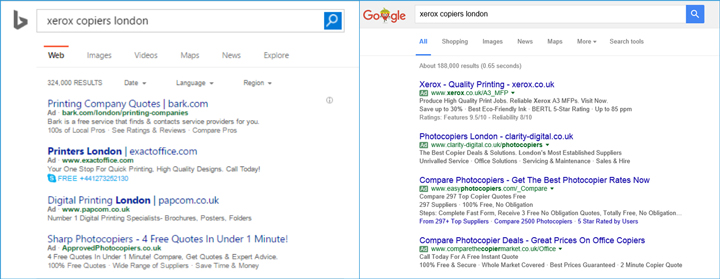Digital marketing and sales tactics grow exponentially as new platforms, tools and ideas pop-up daily. It can be overwhelming to keep track of what your next best marketing move should be – especially when you’re wearing many hats at any given time.
We already addressed the importance of local listings on both Google and Bing, covering why local search is important and how to make sure your listings are up-to-date. We also talked about the importance of a website, why it’s the heart of online inbound marketing strategy and gave advice from other Xerox Channel Partners on how to build a great one.
Recently we discussed the basics of Search Engine Optimization (SEO) and the benefits of being found organically in search results. Now we’re touching on Pay-Per-Click advertising (PPC), also known as Search Engine Marketing (SEM) and how it helps boost visibility and drive awareness and demand online.
Where does your PPC ad show up?
On Google and Bing, the first few spots are paid ads followed by local listings and then organic search results obtained through SEO. The top page placement makes PPC attractive, powerful and depending on the placement and keyword you’re looking to rank for, can be more or less expensive.

The difference between SEO and SEM
Whilst SEO is a long-term strategy. SEM, by contrast, can be instant gratification. It’s more expensive with quicker results. But when done without purpose, it’s a gamble – not in the favor of a novice.
Five essentials for a successful PPC campaign:
Don’t run a campaign on a product you don’t have
This may sound obvious, but it happens more often than you might think. Because PPC is easy to set up through the search engine interface, people think pointing to products with high margins will net better profits. But when you don’t have the product in stock, you’ve driven demand for something you can’t readily deliver, leaving the buyer waiting for something they wanted now and an opportunity to go elsewhere to get it sooner.
Expect visitors to look around
Pay-per-click ads drive potential customers to a page on your website and we all know what that means; they come in on your PPC ad, but chances are something else will catch their eye while they’re there. Make sure your product and services pages are in tip-top shape before executing a campaign. Include calls-to-action for newsletter sign-ups, highlight current sales and provide them with the information they need to make the right decision with your offers.
Google analytics make a difference
Knowing your audience is rule #1 in marketing and PPC is no exception. When Google Analytics are connected to your website, the data you can mine about customers, campaigns, devices, geographies and other demographics of the visitors to your site is practically endless. Use this data to track the link you’re using on the PPC ad and trace where on the website those visitors go after they enter from that link.
Write persuasive copy
Your basic PPC ad will have a headline, short space for text and a link. Make the best use of space and create a headline that addresses the needs of the buyer. Simple functional copy works best. Entice them to click and send them to a well-written landing page that is, informative, and solves their pain. On that landing page include compelling copy, a call-to-action and an offer like an e-book, sign-up for tips, or a free demo or assessment. Capturing their email will allow you to continue to market to them in other ways. If they’re not a customer now, they may become one in the future.
Set a budget – and stick to it
Knowing what you can afford and using the cost restricting features of the PPC platform like X-amount per day will save you from breaking the bank. It will also help you course correct underperforming campaigns before you’ve spent too much.
Plan for success
According to the 2016 Benchmarks, Budgets, and Trends report – North America, the number one advertising method to promote and distribute content is search engine marketing – with 66% of B2B marketers using the tactic.
By taking the time to consider your approach, plan a strategy and execute effectively, not only will you increase the chances of SEM campaigns success – you’ll save money in the long run, whilst driving revenue and growth for your business.
Join our Xerox Channel Partners LinkedIn community
Looking for more marketing tips and insights from Xerox Agents, Concessionaires, and Doocument Technology partners from across the globe? Join our private Xerox Channel Partners LinkedIn Group to connect and discuss topics like these with your peers.
Note: You must be an existing Xerox Channel Partner to join this group – access is closely monitored by Xerox Channel Partner Operations
Subscribe to the Channel Partner Connection and receive email updates when we publish a new article.




[…] but understanding the nuances of paid advertising before getting started is critical. Visit How to Make Sure Your Search Engine Marketing Campaigns Succeed to ensure your money is well […]
really great tips! make sure you target right audience and demographics as this can really decrease your cost on adwords
Great add! Reaching the right audience will definitely reduce customer acquisition costs over time.